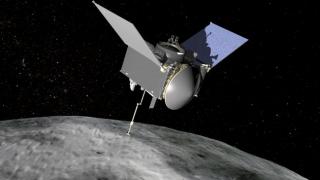This Tuesday October 20th at around 23.12 hr (Canary time) the NASA space probe OSIRIS-REx will make its first attempt to collect samples from the asteroid (101955) Bennu. The Instituto de Astrofísica de Canarias (IAC) has played an active role in the mission since 2011. Researchers Julia de León, Javier Licandro, Eri Tatsumi and Juan Luis Rizos, who are members of the science team of OSIRIS-REx will be present telematically at the meeting organized by this NASA mission so that the science team can follow in real time this dangerous maneuvre¸ using the SamCam camera on board the probe. This event will be one of the most important milestones in the mission.
The prime objective of OSIRIS-REx is the collection of material from the surface of the primitive asteroid Bennu to be examined on Earth. Bennu is an asteroid containing material which has undergone little change from its origin more than 4,000 million years ago. As are other asteroids of this type, it is rich in hydrated minerals and complex organic molecules, so that studying this material just as it is, on the asteroid can give us clues to inderstand how these materials reached the Earth when young, and how they gave rise to the living beings which inhabit Earth today.
The OSIRIS-REx probe took off from Cape Canaveral on September 8th 2016. It arrived at the asteroid at the end of 2018, and since then it has been in orbit around it, carrying out various studies of its composition, structure and behaviour. The Solar System group at the IAC is part of the team which is working with the cameras on board the probe (called OCAMS) and has participated actively in the calibration and the science which are resulting from its images, and which have also been important for selecting the site where there will be an attempt to collect samples.
For de León and Licandro, who were present in person at the launch of the mission in 2016, it is a historic moment. “We have arrived, we have studied, and now comes the difficult part, to collect a bit of Bennu to bring back to Earth for study”. To do this entials great difficulty. The probe has to go down to an object barely 500m big, which is moving at 10,000 km/h, with almost no gravity and with a surface covered with rocks, between a few centimetres and tens of metres in size. Once there, the probe must make a maneuvre called “Touch-and-Go”, which is highly risky. The probe must make an approach at very low velocity and open a mechanical arm 3.35m long, which has at its tip a mechanism for taken samples, ensure that this rests on the surface for a few seconds, avoiding contact with any rock which could damage it. This is a real challenge gvien that, in Licandro’s words “Bennu is a huge lump of rock”. The sample collector can pick up grains up to 2 cm big, so that it must make contact at a dusty spot with plenty of small sized material.
OSIRIS-REx will try to take a sample of material from inside a cráter 140m in diameter called Nightingale. It is a zone barely 16m in diameter where there are a lot fewer rocks than on the rest of the surface, and there appears to be sufficient dust. It is hoped to collect a sample of at least 60 grammes. If it doesn’t manage to collect enough, the probe is prepared for making another couple of tries. After that OSIRIS-REx will continue to orbit Bennu and will start its return journey in 2021, taking its precious cargo in a sealed, evacuated jar, which they plan to bring down in the Utah desert in 2023.
NASA will be broadcasting live the “Touch and Go” maneuvre, from 22.00 hr Canary Time, from its NASA TV portal (https://www.nasa.gov/nasalive).
For more information about OSIRIS-REx and Bennu you can visit
https://www.nasa.gov/feature/goddard/2020/bennu-top-ten
Contact at the IAC
- Julia de León: jmlc [at] iac.es (jmlc[at]iac[dot]es)
- Javier Licandro: jlicandr [at] iac.es (jlicandr[at]iac[dot]es)
- Juan Luis Rizos: juan.rizos [at] iac.es (juan[dot]rizos[at]iac[dot]es)
- Eri Tatsumi: etatsumi [at] iac.es (etatsumi[at]iac[dot]es)








